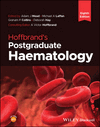Pathogenesis of venous thromboembolism
Henry G Watson
School of Medicine and Dentistry, University of Aberdeen, Scotland, UK
Search for more papers by this authorHenry G Watson
School of Medicine and Dentistry, University of Aberdeen, Scotland, UK
Search for more papers by this authorAdam J Mead PhD, FRCP, FRCPath, FMedSci
Haematopoietic Stem Cell Biology Laboratory, Medical Research Council Molecular Haematology Unit, Medical Research Council Weatherall Institute of Molecular Medicine, University of Oxford, Oxford, UK
Search for more papers by this authorMichael A Laffan DM, MRCP, FRCPath
Department of Immunology and Inflammation, Faculty of Medicine, Imperial College London, London, UK
Search for more papers by this authorGraham P Collins DPhil, FRCP, FRCPath
Department of Haematology, Oxford Cancer and Haematology Centre, Oxford, UK
Search for more papers by this authorDeborah Hay DPhil, MRCP, FRCPath
Nuffield Division of Clinical Laboratory Sciences, Radcliffe Department of Medicine, University of Oxford, Oxford, UK
Search for more papers by this authorA Victor Hoffbrand MA, DM, FRCP, FRCPath, FRCP (Edin), DSc, FMedSci
Emeritus Professor of Haematology Honorary Consultant Haematologist
University College London, London, UK
Royal Free Hospital, London, UK
Search for more papers by this authorSummary
Venous thromboembolism is a multicausal disorder. Thrombosis risk is determined by the combination of an individual's underlying susceptibility combined with acquired risk factors such as age, medical illness, pregnancy and the use of female hormone preparations. The management of patients with VTE is determined by the circumstances surrounding an episode of thrombosis. Patients with thrombosis associated with transient risk factors have lower rates of recurrence than patients with unprovoked episodes or with permanent provoking factors. The management of VTE has centred around anticoagulation only but this may change as pathways involved with inflammation are targeted in future studies.
Selected bibliography
- Baglin T , Luddington R , Brown K , Baglin C ( 2003 ) Incidence of recurrent venous thromboembolism in relation to clinical and thrombophilic risk factors: prospective cohort study . Lancet 362 : 523 – 6 .
- Carrier M , Lazo-Langner A , Shivakumar S et al . ( 2015 ) Screening for occult cancer in unprovoked venous thromboembolism . New England Journal of Medicine . Available at: http://www.nejm.org/doi/full/10.1056/NEJMoa1506623 (accessed 9 August 2015).
- Coppens M , Reijnders JH , Middeldorp S , Doggen CJ , Rosendaal FR ( 2008 ) Testing for inherited thrombophilia does not reduce the recurrence of venous thrombosis . Journal of Thrombosis and Haemostasis 6 : 1474 – 7 .
- NICE Guideline ( 2023 ) Venous thromboembolic diseases: diagnosis, management and thrombophilia testing . NICE guideline NG158. http://www.nice.org.uk/guidance NG158.
- Green-top Guideline ( 2015 ) The acute management of thrombosis and embolism during pregnancy and puerperium (Green-top Guideline No. 37b). https://www.rcog.org.uk/en/guidelines-research-services/guidelines/gtg37b .
- Green-top Guideline ( 2015 ) Reducing the risk of VTE during pregnancy and puerperium (Green-top Guideline No. 37a). https://www.rcog.org.uk/globalassets/documents/guidelines/gtg-37a .
-
Sweetland S
,
Green J
,
Lui B
,
Berrington de González A
,
Canonico M
et al
. (
2009
)
Duration and magnitude of the postoperative risk of venous thromboembolism in middle aged women: prospective cohort study
.
British Medical Journal
3
(
339
):
b4583
. doi: 0.1136/bmj.b4583.
10.1136/bmj.b4583 Google Scholar
- Rosendaal FR ( 1999 ) Venous thrombosis a multicausal disease . Lancet 9159 : 1167 – 73
- Watson HG , Keeling DM , Laffan M et al . ( 2015 ) Guidelines on cancer associated venous thrombosis . British Journal of Haemotology 170 : 640 – 8 .



